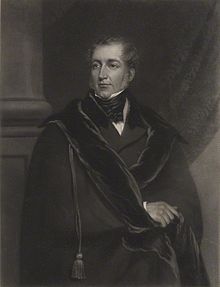Benjamin Hall, 1st Baron Llanover
The Lord Llanover | |
|---|---|
 | |
| President of the Board of Health | |
| In office 14 October 1854 – 13 August 1855 | |
| Monarch | Queen Victoria |
| Prime Minister | The Earl of Aberdeen The Viscount Palmerston |
| Preceded by | New office |
| Succeeded by | Hon William Cowper |
| First Commissioner of Works | |
| In office 21 July 1855 – 21 February 1858 | |
| Monarch | Queen Victoria |
| Prime Minister | The Viscount Palmerston |
| Preceded by | Sir William Molesworth |
| Succeeded by | Lord John Manners |
| Personal details | |
| Born | 8 November 1802 |
| Died | 27 April 1867 (aged 64) |
| Nationality | Welsh |
| Political party | Whig |
| Spouse(s) | Augusta Waddington (m. 1823; wid. 1867) |
Benjamin Hall, 1st Baron Llanover PC (8 November 1802 – 27 April 1867), known as Sir Benjamin Hall between 1838 and 1859, was a Welsh civil engineer and politician. The famous "Big Ben" may have been named for him.
Background
Hall was the son of an industrialist Benjamin Hall. He went to Westminster School.
Political career
He was a Sheriff of Monmouthshire in 1826. He was elected Member of Parliament for Monmouth in May 1831, but his name was erased from the return already in July of the same year. However, he was successfully re-elected for the same constituency in December 1832.[1] He was instrumental in the passing of the Truck Acts of 1831 and campaigned against the abuse of parliamentary election expenses and championed the right of people in Wales to have religious services in Welsh. He also engaged in bitter controversy with the bishops on the state of the Anglican church in Wales and made attacks on the shameless exploitation of church revenues, complaining of unbounded nepotism.[2] In 1837 he was returned for Marylebone[3] and the following year he was created a baronet.[4]
He served under Lord Aberdeen and then Lord Palmerston as President of the Board of Health between 1854 and 1855 and was sworn of the Privy Council in 1854.[5] In 1855 he introduced an Act of Parliament which led to the establishment of the Metropolitan Board of Works. He became First Commissioner of Works the same year and was responsible for many environmental and sanitary improvements in London.[6] He oversaw the later stages of the rebuilding of the Houses of Parliament, including the installation of the 13.8-tonne hour bell, "Big Ben", in the clock tower. He was a tall man and many attribute its name to him, but this is questionable.[7] Through his wife, Hall inherited the Llanover estate in Monmouthshire. He remained as First Commissioner of Works under parliament until the Whigs lost power in 1858. The following year he was elevated to the peerage as Baron Llanover, of Llanover and Abercarn in the County of Monmouth.[8] From 1861 to 1867 he was Lord Lieutenant of Monmouthshire.[9]
Personal life
Lord Llanover married Augusta, daughter of Benjamin Waddington of Ty Uchaf, Llanover, in 1823. Only one of their daughters reached adulthood. Augusta married Arthur Jones of Llanarth. Their son was Ivor Herbert, 1st Baron Treowen. Lord Llanover died in April 1867, aged 64, when the baronetcy and barony became extinct. Lady Llanover survived him by almost thirty years and died in January 1896.
References
- ^ leighrayment.com House of Commons: Mitcham to Motherwell South
- ^ Friends of Torfaen Museum Trust. St. Bartholomew's Church, Llanover. 1996 See: http://www.roger.j.moss.btinternet.co.uk/church-history/lh.lwp/lh.htm[dead link]
- ^ leighrayment.com House of Commons: Macclesfield to Marylebone West
- ^ "No. 19631". The London Gazette. 3 July 1838.
- ^ "No. 21629". The London Gazette. 17 November 1854.
- ^ Halliday S. The Great Stink of London. Thrupp, Gloucestershire: Sutton; 1999, p 59.
- ^ Whitechapel Bell Foundry The Story of Big Ben See: http://www.whitechapelbellfoundry.co.uk/bigben.htm - but see "The Welshman", 31 October 1856, p.8.
- ^ "No. 22280". The London Gazette. 28 June 1859.
- ^ leighrayment.com The Peerage: Linklater of Butterstone to Lonsdale
External links
- Use dmy dates from March 2012
- 1802 births
- 1867 deaths
- People educated at Westminster School, London
- Barons in the Peerage of the United Kingdom
- British civil engineers
- Lord-Lieutenants of Monmouthshire
- Members of the Privy Council of the United Kingdom
- High Sheriffs of Monmouthshire
- Members of the Parliament of the United Kingdom for Welsh constituencies
- Members of the Parliament of the United Kingdom for English constituencies
- UK MPs 1831–32
- UK MPs 1832–35
- UK MPs 1835–37
- UK MPs 1837–41
- UK MPs 1841–47
- UK MPs 1847–52
- UK MPs 1852–57
- UK MPs 1857–59
- Whig (British political party) MPs
